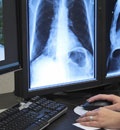Guest article by David Watts

Even in an era where you can check your email before getting out bed, the majority of medical establishments (doctor’s offices, hospitals, insurance companies) still use paper records to keep information about their patients.
An electronic medical record (EMR) is a system of recording, storing, accessing, and exchanging patient records. EMRs are simply text information stored on some form of digital media. EMR systems are generally complemented by a picture archiving and retrieval system (PACS) that is used for the storage and recovery of various medical images (primarily radiological images). Despite numerous benefits of the digitization of medical records, most doctors are still reluctant to switch to electronic records because of cost and convenience. In contrast to what these doctors think, the transition to EMR and PACS systems is relatively simple and will greatly increase the accessibility and convenience of patient records.
EMR systems offer significant improvement on several aspects of the medical evaluation process.
First and foremost, the ease of exchange of medical records is an obvious benefit of EMRs. With more of the world’s population becoming increasingly mobile, fewer members of the younger generation will remain with one family doctor over the years. Instead, they will have many doctors, and will have a separate collection of medical information with each one.
Paper records often need to be kept with the doctor who made them, so it is difficult or impossible for patients to get records transferred from doctor to doctor, a process that generally places an increased burden on the nursing and management staff.
Handwriting based systems are marred by the infamous “physician’s handwriting” that sometimes they themselves cannot read. In many cases it is not severe enough to be a problem, but messy handwriting that is misread could easily lead to medical error. An EMR keeps all patient data legible.
It can be continuously updated with patient information instead of having to create a new record every time and can reduce the time a doctor or nurse spends collecting patient information.
The storage of both images in the PACS system and other medical records would be secured by the ability to be “backed up” off site, preventing the loss of precious patient data in fires or floods.
The only potential drawback to EMR systems is security. Like any other digital data, they are subject to illegal retrieval by unauthorized parties accessing the system, but this is arguably as much of a problem for hand-written patient records.
 Many doctors’ offices and hospitals do not realize the ease with which they can purchase and install a system. Dell PACS systems are complete solutions for transferring paper records to EMRs. With such availability and the benefits that an electronic record system has to offer, the next couple years should see a marked increase in the use of EMR technologies.
Many doctors’ offices and hospitals do not realize the ease with which they can purchase and install a system. Dell PACS systems are complete solutions for transferring paper records to EMRs. With such availability and the benefits that an electronic record system has to offer, the next couple years should see a marked increase in the use of EMR technologies.
![]()
The Caregiver’s Voice thanks Dell for sharing this information and for their support.















This is a great article, David. You clearly lay out many of the benefits of EMR systems. [TCV Ed removed link within text. Refer to link next to P. Sharp’s name.]
One of my favorite EMR benefits that we offer at Practice Fusion is that, since we’re web based, your records are available whenever and wherever you want them. You can now chart at home or on the weekends if you’d like…although I don’t recommend it 🙂